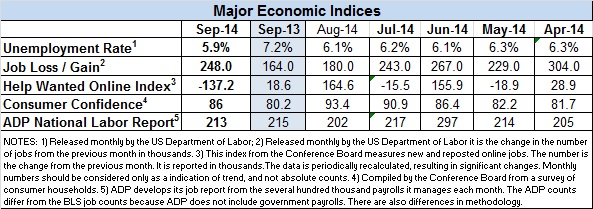Propelled by strong hiring across a range of occupations and industries, September saw 248,000 new jobs added to the economy, which helped drive down unemployment to a six-year low of 5.9 percent.
The monthly jobs report from the U.S. Bureau of Labor Statistics also adjusted upward its count of hiring in August and July, increasing both by a combined 69,000 jobs. August’s initial anemic 142,000 estimate, which surprised analysts and prompted worrying about a hiring pause, was upped to 180,000.
Economists predicted September’s numbers would be in the 215,000 to 220,000 range. The higher number, plus the upward revisions, says that the August slowdown — only the second time this year hiring was under 200,000 — man just have been a blip.
Service sector shows strong gains
“The slower gain initially reported for August now appears to have been simply an aberration,” said Gad Levanon, director of macroeconomic and labor-market research at The Conference Board.
September’s job growth was concentrated in the service sector. Retailers and the leisure and hospitality industry added 35,300 and 33,000 jobs respectively. Grocers added 19,500 jobs, most of them marking the return to work of New England’s striking Market Basket employees. Restaurants and bars hired 20,400 new workers.
Other sectors showing hiring strength:
- Health care, up 22,600, the bulk coming from home health care and outpatient facilities;
- Employment services hired 33,600 new workers, with temp agencies accounting for 19,700;
- Professional and technical services added 21,100 positions, including jobs for architects and engineers, software developers and management and technical consultants;
- The financial sector was up 12,000 jobs, a nice gain for one of the sectors hardest hit by the recession.
Goods producers added only 29,000 jobs, with manufacturing contributing 4,000 and construction adding 16,000. Mining added 9,000.
Workforce participation at lowest level since 1978
Wages and the length of the work week changed little in September. Wage growth has been mostly stagnant this year, with hourly pay rates rising only 2 percent. The average workweek for all employees on private non-farm payrolls was 34.6 hours in September.
The BLS report also showed participation in the labor force is continuing to contract, which is a factor in bringing down the unemployment rate. September’s rate of 62.7 percent was the lowest since 1978. Even if no new jobs were being created, the unemployment rate would be decreasing since there are fewer workers employed or looking for work.
